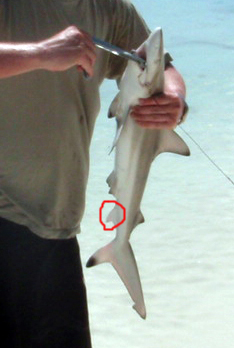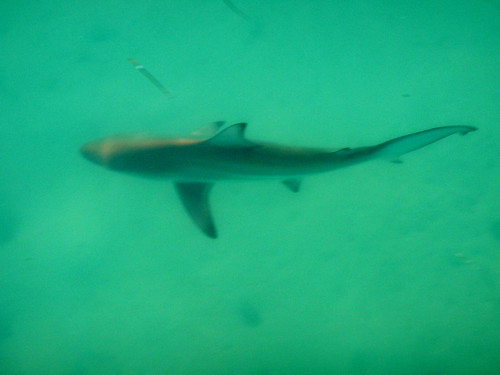So something has been grating at me. I recently went through my shark list (yes; I keep a shark list - it really makes much more sense than keeping a world bird list - and you can see it here) and having thought long and hard about whether to include a couple of sightings (one went on the list, one didn't) and taxonomy (bye bye guitar sharks) I'm on the distinctly unround number of 29. This wasn't how it was supposed to be. You see last year, before our white shark extravaganza, we planned a couple of dives in California's kelp which should have/could have yielded a joyous bounty of new species including leopard sharks, grey or brown smooth hounds, horn sharks, swell sharks, pacific angel sharks, soupfin sharks or even a couple of others. Unfortunately one of the dives ended up being on a deep sharkless wreck and the other in the kelp was in appalling zero viz conditions with no sightings which left me on 28 which plus Carcharadon = 29. I'd really like to hit the 30 mark so I've been chafing a little to try and pick up an extra species here in the Caribbean. Now one extra species that is a definite possibility is the Mokaran or Great Hammerhead, largest of all the hammers. People very occasionally describe seeing hammers here and they should be here but I've yet to see pictures from our island nor have I heard an entirely credible report first hand. In other words I'm going to have to be very, very, very lucky indeed. Another option would be the Caribbean Sharpnose shark - a plucky little shallow water species I'm unlikely to see diving but which I may well come across whilst fishing or wandering the shore being vigilant. This seems doable but I have no reports at all to go on.
Far more likely is something from the genus Carcharhinus ie the requiem sharks, we've already bagged a number of those on the list (bull, blacktip, blacktip reef, silky, grey and caribbean reefs.....) but there are a lot of others. A number of species in this genus are, I remain convinced, persistently misidentified by dive guides and divers as generic "reef sharks" (by way of evidence, many people out here tell me they saw a blacktip reef shark on their dive; a species only found in the pacific). Blacknose sharks (Carcharhinus acronotus) for example were seen regularly on a shark feed in St. Martin until recently but it was only because one guy recognised them that this was picked up. Blacknose is certainly a target but another species is firmly in my cross hairs for number 30. The Spinner shark (Carcharhinus brevipinna) is certainly a possibility here and is so easily confused with blacktip sharks (Carcharhinus limbatus) it is easily overlooked. So on a recent trip where I was seeing blacktips regularly the grilling commenced in earnest.
Fishing off a pier I noticed some small Carcharhinid sharks expressing an interest in my baits (I was fishing for tarpon but the little sharks are an occupational hazard of using fish chunks as bait here). This slightly bigger shark was the first to come close enough for a decent look and she is a........
Blacktip. The give away here is the position of the dorsal fin (the top one) in relation to the pectorals (the two big side ones). On the spinner the dorsal starts further back, in line with or behind the trailing edge of the pectorals. Shortly after losing a monumental tarpon after a frankly Hemmingwayesque battle my rod tip bent round and I hooked a tiny but prodigiously greedy little shark. On the way in she threw herself into the air several times spinning wildly. This is the behaviour that gave spinner sharks their name; was I seeing my 30th species of wild shark? Well here's a photo of our little girl being very delicately unhooked and released unharmed by yours truly.

Far more likely is something from the genus Carcharhinus ie the requiem sharks, we've already bagged a number of those on the list (bull, blacktip, blacktip reef, silky, grey and caribbean reefs.....) but there are a lot of others. A number of species in this genus are, I remain convinced, persistently misidentified by dive guides and divers as generic "reef sharks" (by way of evidence, many people out here tell me they saw a blacktip reef shark on their dive; a species only found in the pacific). Blacknose sharks (Carcharhinus acronotus) for example were seen regularly on a shark feed in St. Martin until recently but it was only because one guy recognised them that this was picked up. Blacknose is certainly a target but another species is firmly in my cross hairs for number 30. The Spinner shark (Carcharhinus brevipinna) is certainly a possibility here and is so easily confused with blacktip sharks (Carcharhinus limbatus) it is easily overlooked. So on a recent trip where I was seeing blacktips regularly the grilling commenced in earnest.
Fishing off a pier I noticed some small Carcharhinid sharks expressing an interest in my baits (I was fishing for tarpon but the little sharks are an occupational hazard of using fish chunks as bait here). This slightly bigger shark was the first to come close enough for a decent look and she is a........
Blacktip. The give away here is the position of the dorsal fin (the top one) in relation to the pectorals (the two big side ones). On the spinner the dorsal starts further back, in line with or behind the trailing edge of the pectorals. Shortly after losing a monumental tarpon after a frankly Hemmingwayesque battle my rod tip bent round and I hooked a tiny but prodigiously greedy little shark. On the way in she threw herself into the air several times spinning wildly. This is the behaviour that gave spinner sharks their name; was I seeing my 30th species of wild shark? Well here's a photo of our little girl being very delicately unhooked and released unharmed by yours truly.

Notice the white fin I've ringed in red? You'd expect a shark with a name like the "blacktip" to have black tips on those wouldn't you? Well as it turns out no. If she had a black tip to that fin it would be a good shout to suggest she were a spinner but as it happens blacktips have a white anal fin.....because all this isn't confusing enough already. So I remain on 29, busily grilling every shark I come across for signs of abnormality, black bits, white bits, pointier than usual noses and so on. I actually have a fairly good idea that my next shark isn't going to come in the caribbean and may well be one of the less awe-inspiring species; only time will tell.


3 comments:
I absolutely love that last photo! It's like the sneaky grin before you're chomped... Too funny!
I love it too Jason - as you might have guessed from the black and white, it took quite a lot of editing; taking pictures in water that shallow is surprisingly difficult (as unfortunately is hand positioning on the fish to make sure you a) get the picture but b) don't get bitten).
On the subject of chomping I doubt you'd believe the size of bait these little chaps were capable of swallowing!
A shark list makes perfect sense to me.
Love the photos of the little biters.
Post a Comment